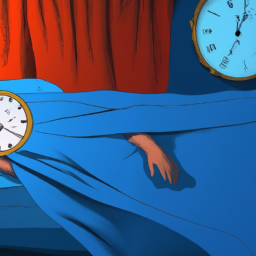Dream Meaning
How To Forget Bad Dreams

Have you ever experienced a dream so terrifying that its effects lingered even after waking up? Perhaps it was so realistic that you almost believed it truly occurred. That describes my experience precisely when, last week, I dreamt of being pursued by a beast in a forest. Despite understanding it was all in my head, the apprehension and unease persisted all day.
It’s not uncommon for people to experience bad dreams or nightmares, but they can be distressing and impact our mental health.
Fortunately, there are ways to cope with and forget bad dreams. In this article, we’ll explore research-based techniques to help process and release negative emotions associated with bad dreams. From cognitive reframing to relaxation techniques, we’ll cover various strategies that can help ease your mind when faced with unsettling imagery during sleep.
Whether you’re looking for immediate relief or long-term solutions, these tips can provide practical support in managing difficult dreams and improving overall well-being.
Key Takeaways
- Journaling can help process emotions and uncover underlying subconscious issues related to bad dreams.
- Techniques such as cognitive reframing, relaxation techniques, and engaging in relaxing activities can help cope with bad dreams.
- Creating a peaceful sleep environment through adjustments such as adding plants, limiting caffeine intake, and avoiding electronic devices can improve sleep quality.
- Mindfulness practices, forgiveness, and letting go of negative emotions can help stay grounded in the present moment and reduce stress levels.
Acknowledge and Process the Dream
You gotta let yourself feel the emotions from that nightmare, and then process it by asking yourself what it could potentially mean for you. Dream interpretation can be a powerful tool to help identify any underlying fears or anxieties that may have triggered the bad dream.
Journaling techniques can also be useful in processing the dream. Writing down the details of the nightmare and exploring any emotions or thoughts that arose during and after the dream can help uncover any subconscious issues that need addressing.
It’s important to acknowledge and process these dreams instead of trying to push them aside or forget about them altogether. Ignoring these nightmares can lead to increased anxiety and stress, ultimately making it more difficult to relax and get a good night’s sleep.
Once you’ve processed the dream, you can move on to relaxation techniques such as deep breathing, meditation, or visualization exercises to help calm your mind before bed.
Relaxation Techniques
By practicing deep breathing and visualization, it’s possible to ease the mind and release tension.
Deep breathing is a relaxation technique that helps to calm the body and reduce stress levels. To do this, sit or lie down in a comfortable position and take deep breaths in through your nose and out through your mouth. Focus on the sensation of the air moving in and out of your body, letting go of any thoughts or worries.
Visualization techniques involve imagining yourself in a peaceful setting, such as lying on a beach or walking through a forest. As you visualize this scene, try to engage all of your senses – what can you see, hear, smell? The more vividly you can imagine yourself there, the more relaxed you’ll feel.
By combining deep breathing with visualization techniques, you can create a powerful relaxation tool that can help to soothe an anxious mind.
Once you’ve relaxed your body and eased your mind using these techniques, it’s time to start working on changing how you think about bad dreams.
Cognitive Reframing
To shift your perspective on unsettling dreams, try reframing them as opportunities for growth and self-reflection. Reframing techniques involve changing the way you think about a situation to create a more positive outlook. Instead of dwelling on the negative aspects of a bad dream, focus on what you can learn from it.
One positive thinking strategy is to identify any recurring themes in your dreams and use them as clues to uncover underlying emotions or issues that may need attention in your waking life. For example, if you frequently dream about being chased, it could indicate feelings of anxiety or fear that need to be addressed. By reframing these dreams as opportunities for personal growth and insight, you can turn a negative experience into a positive one.
By using cognitive reframing techniques, you can transform bad dreams into valuable learning experiences. However, if this approach doesn’t work for you, there are other strategies to help forget bad dreams. One effective method is to distract yourself by engaging in activities that bring joy and relaxation.
Distract Yourself
When I experience bad dreams, one way I distract myself is by engaging in a relaxing activity like yoga or meditation.
Another effective method for me is to watch a funny video that makes me laugh and takes my mind off the negative thoughts.
Lastly, listening to soothing music has also helped me to calm down and feel more at ease after a disturbing dream.
These are all evidence-based techniques that can be used to distract oneself from unpleasant experiences and promote mental wellness.
Engage in a Relaxing Activity
Relaxing with a favorite hobby or activity can help distract your mind from bad dreams and promote a sense of calm. Engaging in activities like painting, writing, or playing music can be an effective way to reduce stress and anxiety. These activities allow you to focus on something positive and enjoyable, which can help take your mind off of negative thoughts.
In addition to hobbies, there are other relaxation techniques that may be helpful for forgetting bad dreams. Meditation tips and nature therapy are two methods that’ve been shown to reduce stress levels and promote relaxation. Taking a walk outside or practicing deep breathing exercises can also be beneficial.
Remember that what works best for one person may not work as well for another, so it’s important to experiment with different techniques until you find what works best for you.
Transitioning into the next section about ‘watch a funny video’, it’s important to remember that laughter is often the best medicine when it comes to reducing stress levels and promoting relaxation. So if all else fails, watching a funny video online may be just the thing you need to forget those unpleasant dreams!
Watch a Funny Video
Engaging in a relaxing activity is a great way to calm your mind and ease the tension caused by a bad dream. However, sometimes we need something more lighthearted to completely shake off the negative emotions that linger from the nightmare. This is where watching a funny video comes in as an effective tool for forgetting bad dreams.
Laugh therapy has been proven to have numerous benefits such as reducing stress, increasing endorphins, and boosting overall mood. When we watch a comedic video, our brains release dopamine which helps us feel good and forget about any negative thoughts or feelings.
Here are three types of videos you can watch for comedic relief:
1) Stand-up comedy specials on Netflix or YouTube
2) Funny animal videos on social media platforms like TikTok or Instagram
3) Classic sitcoms like Friends or The Office.
By choosing to laugh instead of dwell on the bad dream, we allow ourselves to move forward with positive energy and mindset.
Watching funny videos is just one method for forgetting bad dreams but it can be highly effective when done correctly. If laughter isn’t enough to fully alleviate your anxiety, try combining this technique with other relaxation methods such as deep breathing or meditation.
Next up, let’s explore another way to ease our minds after experiencing a disturbing dream – listening to soothing music.
Listen to Soothing Music
To calm your mind and ease any anxiety, try listening to soothing music that makes you feel at peace. Music has been used for centuries as a way to promote relaxation and reduce stress levels. In fact, research has shown that music therapy can be an effective treatment for a variety of mental health disorders, including anxiety and depression.
There are many different types of soothing music that you can listen to depending on your personal preferences. Classical music, such as Bach or Mozart, is often recommended for its calming effects on the mind and body. Other options include nature sounds like rain or ocean waves, white noise or ambient sounds like wind chimes or soft bells. Whatever type of soothing music you choose, make sure it’s something that resonates with you personally so that you can fully reap the benefits of this simple yet powerful technique.
Transitioning into the subsequent section about ‘change your sleep environment’, creating a peaceful atmosphere in your bedroom can also help alleviate bad dreams.
Change Your Sleep Environment
Switching up your sleeping quarters can be a great way to improve sleep hygiene and create a more relaxing environment. Your bedroom decor plays an important role in setting the tone for restful sleep. Here are three simple changes you can make to your sleep environment to help forget bad dreams:
-
Add some greenery: Plants not only add a touch of nature to your room, but they also help purify the air and reduce stress levels.
-
Upgrade your bedding: Investing in high-quality sheets, blankets, and pillows can make all the difference in creating a comfortable sleeping space.
-
Adjust lighting: Soft, warm light is ideal for creating a calming atmosphere before bed. Consider adding dimmer switches or using lamps with low-wattage bulbs.
Making these small changes to your sleep environment may seem insignificant, but they can have a big impact on the quality of your sleep and overall well-being.
By creating an inviting space that promotes relaxation and calmness, you’ll be better equipped to leave bad dreams behind and wake up feeling refreshed.
Creating a peaceful sleeping environment is just one aspect of practicing self-care. In addition to adjusting our surroundings, we must also take care of our minds and bodies through healthy habits like exercise, meditation, and proper nutrition.
Practice Self-Care
When it comes to practicing self-care, there are a few key areas that I focus on in my own routine.
Firstly, I make sure to exercise regularly as this not only helps me physically but also improves my mental health and reduces stress levels.
Secondly, I prioritize eating a balanced diet as this provides me with the energy and nutrients needed for optimal functioning.
Lastly, getting enough sleep is crucial for overall well-being and allows me to feel refreshed and ready to tackle the day ahead.
By prioritizing these areas of self-care, I’m able to maintain a healthy lifestyle both physically and mentally.
Exercise Regularly
By incorporating regular exercise into my routine, I can not only improve my physical health but also ward off recurring bad dreams and promote better sleep. Consistency is key when it comes to exercising for better sleep. Finding enjoyable exercises that I look forward to doing regularly, such as hiking or dancing, can make all the difference in maintaining a consistent workout routine.
In addition to consistency, there are several ways exercise can help reduce the frequency of bad dreams:
- Exercise releases endorphins that reduce stress and anxiety levels, which are known triggers for bad dreams.
- Regular exercise helps regulate my circadian rhythm, making it easier to fall asleep and stay asleep throughout the night.
- By tiring out my body through exercise, I’m more likely to enter a deeper stage of sleep where dreaming is less frequent.
- Exercise improves overall physical health, which has been linked to better sleep quality.
- Incorporating relaxation exercises such as yoga or stretching into my routine can further reduce stress levels and promote better sleep.
By improving my physical health through regular exercise and reducing stress levels through relaxation techniques, I’m setting myself up for a better night’s sleep with fewer bad dreams. However, it’s important to remember that diet also plays a role in promoting good sleep habits.
Eat a Balanced Diet
Maintaining a balanced diet can have a significant impact on the quality of my sleep and overall health, coincidentally leading to fewer restless nights. It’s important to make healthy meal choices throughout the day and incorporate nutrient-rich food options that provide me with enough energy for my daily activities.
Research shows that consuming foods high in sugar, caffeine, or processed ingredients can lead to disrupted sleep patterns as well as increased anxiety and stress levels. To ensure I’m getting all the necessary nutrients for my body, I aim to include a variety of fruits, vegetables, lean proteins, and whole grains in my meals. I also try to limit my intake of alcohol and sugary drinks before bedtime as they can interfere with falling asleep quickly.
By making conscious choices about what I eat throughout the day, I’m able to promote better sleep quality and overall health. Incorporating healthy eating habits into my daily routine is just one step towards achieving more restful nights. To continue improving my sleep habits, it’s important that I get enough sleep each night by establishing a regular bedtime routine.
Get Enough Sleep
Getting enough sleep is crucial for overall health and well-being, so it’s important to establish a consistent bedtime routine. One of the best ways to improve sleep is by practicing good sleep hygiene, which includes limiting caffeine intake before bed, avoiding electronic devices in the bedroom, and creating a relaxing environment.
In addition, it’s important to prioritize getting enough sleep each night. This means setting aside enough time for restful sleep and sticking to a regular schedule as much as possible. By prioritizing sleep and establishing healthy habits, we can improve our ability to fall asleep quickly and stay asleep throughout the night.
However, if you continue to struggle with bad dreams despite making changes to your sleep habits, seeking professional help can be an effective next step in finding relief.
Seek Professional Help
Sometimes it’s best to seek professional help in order to forget bad dreams. Therapy benefits individuals who have recurring nightmares or traumatic experiences that affect their daily life. Finding a therapist can be an easy process, as there are numerous resources available online and through referrals from healthcare providers.
Therapists provide a safe space for individuals to share their experiences without judgment. They use evidence-based techniques such as Cognitive Behavioral Therapy (CBT) and Exposure Therapy to help individuals cope with their nightmares. Therapists also teach relaxation techniques such as deep breathing and meditation to reduce anxiety levels. In some cases, therapists may recommend medication to manage symptoms of anxiety or depression.
Overall, seeking professional help can be a positive step towards forgetting bad dreams and improving one’s mental health. However, it’s important to remember that therapy is not a quick fix solution and requires time and commitment.
Transitioning into the next section about avoiding triggers, it’s important to note that while therapy can be helpful in managing bad dreams, identifying triggers that lead to nightmares is also essential for long-term relief.
Avoid Triggers
When I have bad dreams, I know that avoiding triggers can help me prevent them from happening in the future.
One way to do this is by limiting stimulants before bedtime, such as caffeine or alcohol.
I also try to reduce stressful situations and create a relaxing bedtime routine, like taking a warm bath or reading a book before sleep.
Research shows that these practices can promote better sleep and reduce the likelihood of having unsettling dreams.
Limit Stimulants Before Bed
To improve your chances of forgetting bad dreams, try avoiding stimulants like caffeine or sugar before bedtime. Studies have shown that consuming these substances can lead to disrupted sleep and increase the likelihood of vivid or intense dreaming. Instead, opt for calming beverages such as herbal tea or warm milk to help relax your mind and body before sleeping.
It’s also important to note that alcohol consumption should be avoided before bedtime as well. While it may initially make you feel drowsy, it can actually disrupt the quality of your sleep and lead to more frequent awakenings throughout the night. By reducing caffeine and alcohol intake, you can create a healthier sleep environment and improve your ability to forget any unpleasant dreams you may have had during the night.
Moving on to reducing stressful situations in our next section…
Reduce Stressful Situations
If you’re looking to improve your sleep and reduce the frequency of vivid or intense dreams, it’s a good idea to work on reducing stressful situations in your life. Stress management is key to promoting better sleep hygiene and reducing the likelihood of nightmares.
Here are four ways to help reduce stress in your daily routine:
- Practice mindfulness techniques such as meditation or deep breathing exercises.
- Make time for self-care activities such as taking a relaxing bath or reading a book.
- Prioritize tasks that need to be done and delegate responsibilities when possible.
- Seek support from friends, family, or a therapist when needed.
By implementing these strategies into your daily routine, you can begin to manage stress more effectively and promote better sleep patterns. Creating a relaxing bedtime routine can further enhance this process by providing an environment conducive to restful sleep without distractions or disruptions.
Create a Relaxing Bedtime Routine
Reducing stressful situations can be a great way to prevent bad dreams, but sometimes it’s not enough. As someone who’s struggled with recurring nightmares, I know how important it is to have a relaxing bedtime routine.
One of the best ways to do this is through mindfulness meditation and aromatherapy techniques. Mindfulness meditation involves focusing on your breath and being present in the moment. This can help calm your mind and reduce anxiety before bed.
Aromatherapy techniques involve using scents like lavender or chamomile to promote relaxation and sleep. You can use essential oils in a diffuser, spray them on your pillow, or take a warm bath with scented salts.
By incorporating these practices into your bedtime routine, you may find that you fall asleep more easily and wake up feeling refreshed.
Now let’s move on to the next section about using affirmations as another tool for forgetting bad dreams.
Use Affirmations
By repeating positive phrases, I’ve found that affirmations can help me overcome the negative impact of bad dreams on my mental health. Positive self-talk is a powerful way to change how we think and feel about ourselves. Instead of allowing negative thoughts to take root, I consciously choose to focus on positive affirmations that remind me of my strengths and capabilities.
Visualization techniques are also effective in dealing with bad dreams. By visualizing myself achieving my goals and living a happy life, I create a positive mental image that helps counteract any negative emotions or fears associated with bad dreams.
Using these techniques has helped me let go of negative thoughts and replace them with positive ones, leading to better overall mental health and well-being.
As I continue on my journey toward forgetting bad dreams, embracing the power of forgiveness is another important step in this process.
Embrace the Power of Forgiveness
I’ve found that embracing the power of forgiveness has been an incredibly effective way to let go of bad dreams and move forward in a positive direction.
When I forgive myself and others, I’m able to release any resentment and guilt that may be holding me back.
It’s important to focus on the present moment when practicing forgiveness, as dwelling on past mistakes or grievances can prevent us from truly letting go.
By forgiving ourselves and others, we can lighten our emotional load and create space for positivity in our lives.
Forgive Yourself and Others
You can start to heal from bad dreams by forgiving yourself and others. Self-forgiveness is the first step in this process as it allows us to let go of any guilt or shame we may feel about our own actions that contributed to the bad dream.
It’s important to remember that everyone makes mistakes, and holding onto negative emotions towards ourselves only hinders our ability to move forward.
Forgiving others is also crucial in releasing any negative emotions related to a bad dream. Holding onto resentment towards someone who may have hurt us in the past only perpetuates those feelings and keeps us stuck in a negative mindset.
By choosing to forgive, we’re not condoning their actions but rather freeing ourselves from the burden of anger and bitterness. This act of forgiveness allows us to let go of any negative emotions associated with the person or situation, giving us space for more positive thoughts and experiences.
As we learn how to forgive ourselves and others, it becomes easier to let go of resentment and guilt. We can focus on moving forward with positivity, allowing for personal growth and healing from past traumas.
Letting go of these negative emotions sets the foundation for creating a more fulfilling future free from the constraints of our past experiences.
Let Go of Resentment and Guilt
It’s time to release the weight of resentment and guilt that may be holding me back from personal growth and healing. Negative emotions can take a toll on my mental health, leading to anxiety, depression, and even physical symptoms.
To let go of resentment and guilt, I need to practice mindfulness by acknowledging my feelings without judgment or criticism. I can start by examining why I am holding onto these negative emotions. Am I blaming myself for something that wasn’t entirely my fault? Or am I resentful towards someone who has hurt me in the past?
Once I identify the root cause, I can work on releasing it through self-compassion and forgiveness. This process may take time, but with patience and persistence, I can free myself from the burden of negative emotions. By letting go of resentment and guilt, I can focus on living in the present moment with a clear mind and heart.
Transitioning into the next section about focusing on the present moment, it’s essential to remember that we cannot change the past or control the future. All we have is this very moment, which is why practicing mindfulness is crucial for our well-being. Let’s explore how we can stay grounded in the present moment despite life’s challenges.
Focus on the Present Moment
Stay present and focused on the here and now, letting go of worries about the future or regrets about the past. Mindfulness practices can help you stay grounded in the present moment, even during times of stress.
When we focus on what’s happening right now, we’re less likely to get caught up in anxious thoughts or negative emotions that can fuel bad dreams. One tip for staying focused on the present moment during stressful times is to use your senses to anchor yourself in the here and now.
Take a few deep breaths and notice what you can see, hear, feel, smell, or taste around you. This simple exercise can help you become more aware of your surroundings and reduce feelings of overwhelm. Remember that mindfulness isn’t about trying to control your thoughts or emotions – it’s about accepting them as they are without judgment.
By practicing mindfulness regularly, you may find that bad dreams become less frequent as you learn how to manage anxiety with greater ease and grace.
Frequently Asked Questions
Can bad dreams be a symptom of a larger mental health issue?
Yes, bad dreams can be a symptom of various mental health issues such as anxiety, depression, PTSD, and more. However, therapy techniques like cognitive-behavioral therapy can help manage and alleviate symptoms associated with these disorders.
How long does it typically take for relaxation techniques to start being effective in reducing the frequency of bad dreams?
In my experience, relaxation techniques can start to reduce the frequency of bad dreams within a few weeks of consistent practice. Dream journaling can also aid in identifying patterns and triggers. Keep up the practice for long-term effectiveness.
Are there any specific types of cognitive reframing exercises that work better for bad dreams than others?
I’ve found that cognitive techniques like imagery rehearsal therapy and sleep hygiene practices can be effective in reframing bad dreams. Imagery rehearsal helps rewrite the dream script, while sleep hygiene addresses underlying causes.
How can I tell if a trigger is causing my bad dreams, and what can I do to avoid it?
To identify triggers causing bad dreams, I keep a dream journal and pay attention to patterns. Self-care practices like meditation and deep breathing help manage stress and decrease the likelihood of triggering dreams.
Is it possible for bad dreams to be a sign of a physical health issue?
Bad dreams can be caused by physical or psychological factors. Medical intervention may be necessary for underlying health issues, but self-help techniques like mindfulness and relaxation can also improve sleep quality.
Conclusion
Overall, forgetting bad dreams can be a difficult process, but it isn’t impossible. By acknowledging and processing the dream, practicing relaxation techniques, reframing negative thoughts, distracting yourself, changing your sleep environment, seeking professional help if necessary, avoiding triggers, using affirmations, and embracing forgiveness, you can mitigate the impact of these unpleasant experiences.
One interesting statistic to consider is that according to a study published in the Journal of Sleep Research in 2016, nearly 80% of people report having at least one nightmare within the past year. This highlights that experiencing bad dreams is a common occurrence for many individuals.
However, it’s important to remember that each person’s experience with nightmares or bad dreams is unique and may require different approaches when trying to forget them. Ultimately finding what works best for you may take time and patience but can lead to improved sleep quality and overall well-being.
Manda is the visionary Editor in Chief of Hello Lovely. With an unwavering passion for dreams, Manda ensures that our content is meticulously curated, informative, and engaging.
Their dedication to providing high-quality articles, guides, and resources is evident in the wealth of information available on our platform. Manda’s expertise in dream research, combined with their editorial prowess, helps shape Hello Lovely into a trusted source of dream-related knowledge. Their goal is to create a vibrant dream-centric community where individuals can explore, learn, and connect.
Dream Meaning
When Deceased Visits In Dreams

I frequently hear anecdotes about individuals who have had dream encounters with deceased loved ones. These dreams are described as distinct from ordinary dreams, as they are more lifelike and intense.
In these dreams, the deceased loved one may communicate with the dreamer, provide comfort, or offer a message. Dream visitations from deceased loved ones can be both spiritual and psychological experiences.
They can offer a sense of closure, comfort, and healing to those who are grieving. However, they can also be confusing and unsettling, especially if the dreamer is unsure of what the dream means or why their loved one appeared in the dream.
In this article, we will explore the significance of dream visitations, common themes and experiences, as well as scientific and psychological explanations for these dreams. We will also discuss how to cope with grief and find comfort in dream visitations.
Key Takeaways
- Dream visitations from deceased loved ones offer closure, comfort, and healing.
- Symbolism holds significant meaning and messages in these dreams.
- Emotional reactions provide valuable insight and can help process grief and emotions.
- Dream visitations can be powerful experiences that evoke strong emotional reactions and provide insight into the afterlife and spiritual realm.
What are Dream Visitations from Deceased Loved Ones?
You may have experienced dream visitations from deceased loved ones, which are believed to be a way for them to communicate with you from beyond the physical realm. These dreams can feel incredibly real, as if your loved one is truly present with you.
In my own experience, I’ve had dreams where I’m talking to my grandmother, who passed away several years ago. In these dreams, she always seems to be at peace and offers me words of comfort and guidance.
Dream visitations can be incredibly powerful experiences, offering a sense of connection and comfort for those grieving the loss of a loved one. They can also provide insight into the afterlife and the spiritual realm.
However, these dreams can also be confusing and overwhelming, leaving us with questions about their spiritual and psychological significance.
The Spiritual and Psychological Significance of Dream Visitations
Imagine feeling the presence of a loved one who’s passed on, as if they’re right beside you, offering comfort and guidance. This is the experience of dream visitations, which can have both spiritual and psychological significance.
Here are three ways in which dream visitations can impact our lives:
-
Healing: Dream visitations can help us process grief and come to terms with the loss of a loved one. They offer a sense of comfort and closure that can aid in the healing process.
-
Connection: Dream visitations allow us to feel connected to our deceased loved ones, even after they’ve passed on. This can bring a sense of peace and comfort, knowing that they’re still with us in some way.
-
Guidance: Dream visitations may offer guidance or advice from our deceased loved ones, helping us navigate challenging situations in our waking lives.
Dream visitations can be powerful experiences, impacting our emotional and spiritual well-being.
In the next section, we’ll explore common themes and experiences in dream visitations.
Common Themes and Experiences in Dream Visitations
I find it fascinating how dream visitations from deceased loved ones can bring deep symbolic and meaningful messages. These experiences often evoke strong emotional reactions and responses, which can range from comfort and healing to fear and confusion.
Through exploring these common themes and experiences, we can gain a better understanding of the spiritual and psychological significance of dream visitations.
Symbolism and Meaning
When a deceased loved one visits you in a dream, their presence and the symbolism within the dream can hold significant meaning and messages for you. For example, if you dream of a deceased parent holding a key, this could symbolize that they are unlocking new opportunities for you or guiding you towards a new path in life. Similarly, if you dream of a deceased grandparent cooking your favorite meal, this could represent their love and nurturing presence in your life, even after they have passed.
To better understand the symbolism in your dream, it can be helpful to create a table to track the different elements and their potential meanings. Here is an example of a table you can use:
| Symbolism | Potential Meaning |
|---|---|
| Key | Unlocking new opportunities or guidance towards a new path |
| Cooking | Love and nurturing presence |
| Flowers | Beauty and growth |
By analyzing the symbolism in your dream, you can gain insight and understanding into the messages that your deceased loved one may be trying to communicate to you.
As we explore the different facets of dream visitations, it’s important to also consider our emotional reactions and responses to these experiences.
Emotional Reactions and Responses
Understanding our emotional reactions and responses to these experiences can provide valuable insight into the impact that the visitation has on our subconscious mind.
When I dream about a deceased loved one, my emotional response can vary greatly depending on the nature of the dream. If the dream is peaceful and reassuring, I often wake up feeling comforted and grateful for the visitation. However, if the dream is unsettling or frightening, I can feel shaken and anxious for hours or even days afterwards.
On the other hand, some people may experience a range of emotions from sadness and longing to joy and happiness when dreaming of a deceased loved one. These emotional responses are deeply personal and can be influenced by a variety of factors such as the individual’s relationship with the deceased, the circumstances surrounding their death, and their current state of mind.
Understanding our emotional reactions to these experiences can help us to better process and make sense of them.
Moving on to the subsequent section about scientific and psychological explanations for dream visitations, it’s interesting to explore how these emotional responses can be linked to our subconscious and the impact that the visitation has on our mental health.
Scientific and Psychological Explanations for Dream Visitations
There’s a lot of debate among scientists and psychologists about the validity of dream visitations. Some argue that these experiences are simply a result of our brain’s attempt to process grief and memories. In this view, dream visitations are nothing more than a projection of our own thoughts and emotions.
Others, however, believe that dream visitations are a real and meaningful way for deceased loved ones to communicate with us. These individuals point to the many stories of people who have received important messages or signs from their departed loved ones through dreams. While there’s no concrete proof that dream visitations are real, many people find comfort in believing that their loved ones are still with them in some way.
With this in mind, it’s important to note that there’s no one right way to cope with grief and find comfort in dream visitations. For some, these experiences may provide a sense of closure and peace, while for others they may not hold any particular significance. Ultimately, it’s up to each individual to determine what these experiences mean to them and how they choose to interpret them.
Coping with Grief and Finding Comfort in Dream Visitations
I find comfort in dreaming about my loved ones who’ve passed away. It’s as if they’re still with me, even if it’s just in my dreams.
The healing power of dreams is truly remarkable, and it’s helped me cope with my grief in ways I never thought possible.
For those who’re struggling with loss, there’re many support and resources available to help them through their journey.
The Healing Power of Dreams
Dreams have the ability to soothe and heal our minds and bodies, providing comfort and closure even when we are visited by deceased loved ones. In my experience, dreaming about someone who has passed away can be a powerful form of therapy. It can often feel like they are trying to communicate with us and offer us a sense of peace.
Furthermore, dreams can help us process our grief and make sense of our emotions. They may not always be pleasant, but they can be a safe space where we can work through our feelings and come to terms with our loss. Sometimes, our deceased loved ones may even offer us guidance or advice that we can apply to our waking lives. Dreams truly have the power to provide us with the healing we need during times of grief and loss.
Transitioning into the subsequent section about support and resources for coping with loss, it is important to remember that dreaming is just one way of coping. There are many other resources available to help us navigate the difficult journey of grief, and seeking support from others can be incredibly beneficial.
Support and Resources for Coping with Loss
You can find comfort and assistance in a variety of support and resources when coping with loss. One of the most effective ways to cope is to join a support group for people who are grieving. Being part of a group of people who understand what you’re going through can provide a sense of community and support that is invaluable during this difficult time.
Many support groups offer a safe and non-judgmental space where you can share your feelings and thoughts with others who have experienced similar losses.
Another resource that can be helpful is counseling. Grief counseling can provide you with a trained professional who can help you work through your emotions and develop coping strategies. A counselor can also help you navigate the complex emotions that come with grief and provide you with tools to help you move forward.
Additionally, there are many resources available online and in your community, such as books, articles, and workshops that can help you understand and manage your grief.
No matter what resources you choose, remember that it’s okay to seek help and support when coping with loss.
Frequently Asked Questions
Can dream visitations actually be messages from the deceased?
Yes, dream visitations can be messages from the deceased. I know it may sound unbelievable, but I have experienced it myself. It’s a way for our loved ones to communicate with us beyond the physical world.
Are there any negative consequences or dangers associated with dream visitations?
There can be negative consequences or dangers associated with dream visitations, such as feeling overwhelmed or disturbed by the experience. It’s important to approach these dreams with caution and seek support if needed.
Is it possible for multiple people to have the same dream visitation from the same deceased loved one?
Oh, sure, it’s completely normal for multiple people to have the exact same dream. Especially when it involves a deceased loved one visiting. Nothing to worry about, right?
Do dream visitations always feel comforting, or can they be unsettling or scary?
Dream visitations don’t always feel comforting. Some can be unsettling or even scary. I remember one visit from my deceased loved one where I woke up feeling more anxious than comforted.
Can dream visitations occur even if the person who passed away wasn’t particularly close to the dreamer?
Dream visitations can happen even if I didn’t have a close relationship with the deceased. It’s a comforting feeling to have them visit me, even if it’s just to say goodbye or offer closure.
Conclusion
In conclusion, I believe that dream visitations from deceased loved ones are a powerful and meaningful experience. Whether they’re a spiritual connection or a manifestation of our own psyche, these dreams can bring us comfort and closure during times of grief.
I’ve personally experienced the comfort of these visitations and know that they can provide a sense of peace and healing. As the old saying goes, "when one door closes, another opens."Dream visitations may be that open door, providing us with a connection to our loved ones who have passed on.
While they may not completely erase the pain of loss, they can offer a glimmer of hope and a sense of continuation beyond death. Embrace these dreams and cherish the memories they bring.
Eislyn is a gifted writer whose words weave enchanting narratives within the realm of dreams. With a profound love for storytelling and a deep curiosity about dreams, Eislyn’s articles transport readers into vivid dreamscapes.
Her writing style is both eloquent and thought-provoking, captivating readers’ imaginations and inspiring them to dive deeper into the mysteries of their own dreams. Eislyn’s exploration of dream symbolism and interpretation adds depth and nuance to our content, making it an absolute pleasure for dream enthusiasts to engage with.
Dream Meaning
What Does It Mean When You Have Dreams About Falling

I have experienced my fair share of falling dreams and have always been curious about their meaning. Waking up in a cold sweat after dreaming of falling from a great height can be quite unsettling.
But as it turns out, falling dreams are one of the most common types of dreams that people have, and they can carry a variety of different interpretations.
So, what does it mean when you have dreams about falling? Well, as with any dream interpretation, there’s no one-size-fits-all answer. Falling dreams can mean different things depending on the context of the dream, as well as the individual’s personal experiences and emotions.
In this article, we’ll explore some common interpretations of falling dreams, analyze the context in which they occur, and offer some techniques for coping with them.
Key Takeaways
- Falling dreams are common and can have different interpretations.
- Falling dreams can suggest a lack of control or feeling overwhelmed in waking life.
- Coping techniques include relaxation, meditation, visualization, and positive thinking.
- Seeking professional help may be necessary for persistent distress caused by falling dreams.
Understanding Common Interpretations of Falling Dreams
You’ll want to know that a common interpretation of falling dreams is that you feel a lack of control in your life. Falling dreams often suggest that you’re feeling overwhelmed or out of control in some aspect of your waking life. This could be related to work, relationships, or even your own personal goals and aspirations.
When we feel like we’re falling, we feel powerless and helpless, and this can often translate into our dreams.
To truly understand the meaning of your falling dream, it’s important to analyze the context of your dream. Think about where you were falling from, what you were falling onto, and any other details that stood out to you. This can help give you insight into what your subconscious is trying to tell you.
By taking the time to reflect on your dream, you can start to gain a deeper understanding of yourself and your emotions, and take steps towards regaining control in your waking life.
Analyzing the Context of Your Dream
As I’m analyzing the context of my falling dream, I’m reminded of the saying "actions speak louder than words."The actions and events that occurred in the dream can provide insight into what my subconscious is trying to communicate.
Here are some things to consider when analyzing the context of your falling dream:
- Where are you falling from?
- Are you falling alone or with someone else?
- How do you feel during the fall?
- What happens when you reach the ground?
By answering these questions, I can begin to unravel the symbolism and emotions behind my dream. Understanding the context can help me identify any underlying issues or fears that may be causing the dream.
Exploring possible triggers that may have influenced the dream can also provide valuable information. Perhaps there was something that happened during the day or a recurring issue in my life that’s causing this dream. By exploring these triggers, I can begin to address any underlying issues and work towards resolving them.
Exploring Possible Triggers
Exploring possible triggers for our dreams can be a fun and enlightening way to understand our subconscious better. By identifying the things that may have caused our dream about falling, we can gain insight into our fears and anxieties. Some common triggers for falling dreams include stress, anxiety, feeling overwhelmed, or a lack of control in one’s life.
In addition to these triggers, there may be specific events or experiences that have caused us to dream about falling. For example, if we recently went skydiving or bungee jumping, it’s not uncommon to have falling dreams as our brain processes and makes sense of the experience. By examining our current life circumstances and recent events, we can start to unravel the meaning behind our falling dreams.
Transitioning into the next section, there are techniques we can use to cope with falling dreams and reduce the frequency of them.
Techniques for Coping with Falling Dreams
When I have falling dreams, I find it helpful to practice relaxation and meditation techniques. By focusing on my breathing and clearing my mind, I’m able to reduce my anxiety and stress levels.
Additionally, I’ve found that visualization and positive thinking can also be effective in coping with these types of dreams. However, if falling dreams continue to have a negative impact on my mental health, seeking professional help may be necessary.
Relaxation and Meditation
Meditating is like taking a chill pill for your mind, helping you relax so deeply that even a dream about falling won’t faze you.
When I meditate, I focus on my breath and try to clear my mind of any thoughts or worries. This helps me let go of any stress or anxiety that was weighing me down, allowing me to feel more grounded and centered.
During meditation, I also like to incorporate some visualization techniques to help me feel even more relaxed. For example, I imagine myself floating on a cloud or drifting along a peaceful river. I also like to mentally repeat positive affirmations, such as "I’m safe and protected"or "I trust in the universe to guide me."
These techniques have helped me feel less anxious in my daily life and have also helped me cope with falling dreams. Speaking of which, let’s move on to the next section about visualization and positive thinking.
Visualization and Positive Thinking
Now, let’s dive into how you can use visualization and positive thinking to create a more peaceful and fulfilling life.
Visualization is a powerful tool that allows you to create mental images of your desired outcome. It can be used to reduce stress, increase motivation, and improve overall well-being. By visualizing positive scenarios, you can program your mind to focus on the good things in your life, which can help you to feel more optimistic and hopeful.
Positive thinking is another effective technique that can be used to cultivate a more positive outlook on life. This involves focusing on the good things in your life and reframing negative thoughts into positive ones. By doing so, you can train your brain to see the world in a more positive light, which can lead to increased happiness and well-being.
However, if you find that your dreams about falling are causing you persistent distress or interfering with your daily life, it may be time to seek professional help.
Seeking Professional Help
Sometimes seeking professional help can be the smartest solution for persistent distress caused by dreams of falling. As someone who’s experienced these dreams on a regular basis, I understand how unsettling they can be. It’s important to recognize that these dreams may be a manifestation of underlying anxiety or stress, and seeking help from a therapist or counselor can provide valuable insights and coping strategies.
Here are a few reasons why seeking professional help may be beneficial for those experiencing distressing dreams of falling:
- It can provide a safe and non-judgmental space to explore and process emotions related to the dream.
- A therapist can help identify underlying issues that may be contributing to the dreams and work on addressing them.
- Practicing relaxation techniques and mindfulness can help reduce anxiety and improve overall sleep quality.
- Cognitive-behavioral therapy can help reframe negative thought patterns and reduce the impact of the dreams on daily life.
- Talking to a professional can provide a sense of validation and support, which can be crucial in managing distressing dreams.
Overall, it’s important to prioritize mental health and seek help when needed. Dreams of falling can be a symptom of deeper emotional issues, and addressing these issues through therapy can lead to improved well-being and a better quality of life.
Frequently Asked Questions
Can falling dreams be a sign of a serious medical condition?
I am not a medical professional, but falling dreams are usually not a sign of a serious medical condition. They are typically a result of stress or anxiety and are common for many people.
Are falling dreams more common in certain age groups or demographics?
Falling dreams can happen to anyone, but they may be more common in younger age groups experiencing significant life changes. However, it’s important to not read too much into dreams and focus on real life issues.
Can falling dreams lead to physical symptoms like sleepwalking or night terrors?
I’ve experienced falling dreams that led to sleepwalking and night terrors. These physical symptoms can be a result of the fear and anxiety caused by the dream, but it’s important to talk to a doctor if they persist.
Is there any scientific evidence behind the interpretation of falling dreams?
Falling dreams have been a mystery for centuries. But, there is no scientific evidence to back up the interpretation of these dreams. However, some experts believe that they could indicate a feeling of loss of control in one’s life.
Can recurring falling dreams be a sign of unresolved psychological issues?
Yes, recurring falling dreams may indicate unresolved psychological issues. As someone who has experienced this, I suggest seeking therapy to explore and address any underlying emotional distress that may be causing the dreams.
Conclusion
So, what does it mean when you have dreams about falling? While there are common interpretations, the context of your dream and possible triggers are important to consider.
Falling dreams may symbolize a fear of failure or loss of control, but they can also represent a desire for freedom or overcoming obstacles. It’s important to reflect on your personal feelings and experiences in order to understand the meaning behind your dream.
One example of a falling dream interpretation is a case study of a woman who dreamt she was falling from a tall building. Upon reflection, she realized that she had been feeling overwhelmed and anxious in her personal and professional life. The dream represented her fear of losing control and failing in her responsibilities.
Through therapy and developing coping mechanisms, she was able to address these underlying issues and reduce the frequency of her falling dreams.
Overall, falling dreams can be unsettling, but they can also offer insight into our subconscious thoughts and emotions. By analyzing the context of the dream and identifying possible triggers, we can better understand ourselves and work towards resolving any underlying issues.
Eislyn is a gifted writer whose words weave enchanting narratives within the realm of dreams. With a profound love for storytelling and a deep curiosity about dreams, Eislyn’s articles transport readers into vivid dreamscapes.
Her writing style is both eloquent and thought-provoking, captivating readers’ imaginations and inspiring them to dive deeper into the mysteries of their own dreams. Eislyn’s exploration of dream symbolism and interpretation adds depth and nuance to our content, making it an absolute pleasure for dream enthusiasts to engage with.
Dream Meaning
What Is Dreams Puerto Vallarta Called Now

Dreams Puerto Vallarta used to be a secret paradise located along the Pacific Ocean, resembling a valuable pearl tucked away in a shell. It was an ideal spot for tourists in search of a lavish, all-inclusive getaway in a tropical haven.
However, the resort has undergone a transformation in recent years, leaving many wondering what is Dreams Puerto Vallarta called now?
As a travel enthusiast, I was curious about the rebranding of Dreams Puerto Vallarta and decided to do some research. The resort has a rich history dating back to the 1980s when it was known as Camino Real Puerto Vallarta. It went through several ownership changes before becoming a part of the Dreams Resorts & Spas family in 2010.
But what happened after that? What is the resort called now? And, more importantly, what kind of experience can travelers expect from the rebranded property? In this article, I will answer these questions and more, so keep reading to find out.
Key Takeaways
- Dreams Puerto Vallarta is now called Reflect Krystal Grand Vallarta.
- The resort underwent major renovations and updates.
- Reflect Krystal Grand Vallarta is a brand under AMResorts.
- The resort offers luxurious amenities and stunning ocean views, with easy access to the beach and a short drive to downtown Puerto Vallarta.
History of Dreams Puerto Vallarta
So, what’s the deal? What’s Dreams Puerto Vallarta called now?
Well, it’s still Dreams Puerto Vallarta, but it’s undergone some major renovations since its opening in 1987. I had the pleasure of visiting the resort a few years ago, and let me tell you, the changes were impressive.
It’s no wonder that it’s still a popular destination for travelers seeking a luxurious and relaxing vacation. The original Dreams Puerto Vallarta was a beautiful resort, but it was in need of some updates.
The renovations included new room designs, updated restaurants and bars, and a new spa. The resort also added a new Preferred Club, which offers exclusive privileges and amenities to its members.
With all these upgrades, Dreams Puerto Vallarta has become an even more desirable destination for travelers. But, the rebranding of Dreams Puerto Vallarta didn’t stop there.
Rebranding of Dreams Puerto Vallarta
After undergoing a transformation, the resort has a fresh new identity that captures the essence of its stunning oceanfront setting. Dreams Puerto Vallarta is now known as Reflect Krystal Grand Vallarta, a brand under AMResorts. The rebranding aims to bring a new level of luxury and sophistication to the resort while still maintaining its original charm that attracted guests in the first place.
Reflect Krystal Grand Vallarta retains the same picturesque location, but with newly renovated rooms and updated amenities. The resort offers a range of activities and dining options for guests to enjoy, from relaxing by the pool to experiencing the local culture through cuisine.
I’m excited to share my experience and review of the rebranded resort, which has received high praise from guests for its excellent service and stunning views.
Reviews and Ratings of the Rebranded Resort
Guests are raving about the newly rebranded Reflect Krystal Grand Vallarta, praising its luxurious amenities and stunning ocean views. As someone who’s recently stayed at this resort, I can attest to its excellence.
Here are just a few reasons why this resort is worth considering for your next vacation:
-
The food’s top-notch, with a variety of restaurants to choose from and delicious options for every meal.
-
The staff’s incredibly friendly and attentive, always going above and beyond to make sure your stay’s comfortable and enjoyable.
-
The rooms are spacious and well-appointed, with comfortable beds and beautiful views of the ocean.
-
The location’s ideal, with easy access to the beach and a short drive to downtown Puerto Vallarta.
Overall, Reflect Krystal Grand Vallarta’s a fantastic choice for anyone looking for a luxurious and relaxing vacation. In the next section, we’ll explore some of the features and amenities that make this resort stand out even more.
Features and Amenities of the Rebranded Resort
I’m excited to share with you the features and amenities of the rebranded resort. There are many things to look forward to, including accommodations and room types that cater to different needs and budgets.
Dining and drinking options are abundant, with various restaurants and bars to choose from.
Activities and excursions are also available for those who wish to explore the local area and make the most out of their stay.
Accommodations and Room Types
With a variety of room types available, visitors can choose from luxurious suites to cozy rooms at the newly named Dreams Vallarta Bay Puerto Vallarta. The resort offers various room categories, including Deluxe Rooms, Preferred Club Rooms, and Suites. The Deluxe Rooms feature either a king-size bed or two double beds, while the Preferred Club Rooms offer upgraded amenities and access to the Preferred Club Lounge. The Suites come in different sizes and offer separate living areas, preferred club benefits, and ocean views.
When it comes to dining and drinking options, Dreams Vallarta Bay Puerto Vallarta has seven restaurants and three bars on-site. Each restaurant offers a unique culinary experience, from Italian to seafood, and even a rooftop bar with panoramic ocean views. Guests can also enjoy 24-hour room service and a variety of drink options at the bars.
With so many options, visitors can indulge in delicious cuisine and drinks throughout their stay.
Dining and Drinking Options
Now that we’ve talked about the different types of accommodations and rooms available at Dreams Puerto Vallarta, let’s move on to the dining and drinking options. As someone who loves food, I was excited to see the variety of restaurants and bars available at the resort.
There are six restaurants to choose from, each with a unique theme and menu. From Mexican cuisine at El Patio to seafood at Oceana, there’s something for every taste. And if you’re looking for a more casual dining experience, the World Café offers buffet-style meals throughout the day.
As for drinks, there are several bars scattered throughout the resort, including a swim-up bar and a rooftop lounge. Whether you’re in the mood for a fruity cocktail or a cold beer, you won’t have to go far to find it.
Speaking of being in the mood for something, let’s talk about the activities and excursions available at Dreams Puerto Vallarta.
Activities and Excursions Available
Get ready to experience the thrill of adventure with the wide range of activities and excursions offered at Dreams Puerto Vallarta Resort & Spa. Whether you’re looking for a relaxing day at the beach or a heart-pumping water sport, this resort has something for everyone.
Take a dip in one of the two swimming pools or go snorkeling in the crystal-clear waters of Banderas Bay. You can also go kayaking, paddle boarding, or even take a surfing lesson with the help of the resort’s expert instructors.
If you’re feeling more adventurous, you can book an excursion to explore the nearby jungle, go zip-lining, or take a horseback ride through the mountains. If you’re a fan of marine life, you can go on a whale watching tour or take a sunset cruise. There are also plenty of cultural activities, such as tequila tastings and cooking classes, for those who want to immerse themselves in Mexican culture.
With so many options, you’ll never run out of things to do at Dreams Puerto Vallarta Resort & Spa. Now, let’s move on to some tips for planning a trip to the rebranded resort.
Tips for Planning a Trip to the Rebranded Resort
You’ll want to check out these helpful tips for planning your trip to the newly rebranded resort in Puerto Vallarta. As you prepare for your vacation, keep in mind that the resort is now called Hyatt Ziva Puerto Vallarta. With that in mind, here are some tips to make your stay more enjoyable:
-
Consider upgrading to a club-level room for access to the exclusive lounge, which offers premium drinks and snacks.
-
Make reservations for dinner at the resort’s gourmet restaurants in advance to ensure availability.
-
Take advantage of the resort’s all-inclusive amenities, such as the spa, fitness center, and daily activities and entertainment.
By following these tips, you’ll be well on your way to having a memorable vacation at Hyatt Ziva Puerto Vallarta. Don’t forget to pack your sunscreen and flip flops for some fun in the sun!
Frequently Asked Questions
What are the differences between the old Dreams Puerto Vallarta and the rebranded resort?
The rebranded resort offers a more modern atmosphere than the old Dreams Puerto Vallarta. The rooms have been updated with new furniture and decor, and the restaurant options have expanded. Like a fresh breeze, the changes are invigorating.
Does the rebranded resort offer any new activities or excursions?
I recently visited the rebranded resort in Puerto Vallarta and was pleasantly surprised to find new activities and excursions. Stand-up paddleboarding and a tequila tasting tour were my favorites.
Are there any special deals or promotions currently available for the rebranded resort?
Funny you should ask, I just booked a stay at the rebranded resort in Puerto Vallarta and got a great deal through their website. They’re currently offering discounts on spa treatments and water sports activities.
How has the local community responded to the rebranding of Dreams Puerto Vallarta?
I’m not sure how the local community has responded to the rebranding of Dreams Puerto Vallarta, but I could ask around. My focus has been on finding deals and promotions for the resort.
Can guests still expect the same level of service and quality at the rebranded resort as they did at the old Dreams Puerto Vallarta?
I visited the rebranded resort formerly known as Dreams Puerto Vallarta and found the same level of service and quality. The name change didn’t affect my experience as a guest.
Conclusion
So there you have it, folks – the new and improved Dreams Puerto Vallarta is now known as the Hilton Puerto Vallarta Resort. With its fresh new look and upgraded amenities, this resort is definitely worth considering for your next beach getaway.
From the stunning ocean views to the luxurious spa treatments, there’s something for every type of traveler. So go ahead, indulge in some much-needed relaxation and escape to paradise at the Hilton Puerto Vallarta Resort.
Let the warm sun and crystal-clear waters wash away your worries, and allow yourself to be swept away by the beauty of this stunning destination. After all, life’s too short to miss out on adventures like these.
Eislyn is a gifted writer whose words weave enchanting narratives within the realm of dreams. With a profound love for storytelling and a deep curiosity about dreams, Eislyn’s articles transport readers into vivid dreamscapes.
Her writing style is both eloquent and thought-provoking, captivating readers’ imaginations and inspiring them to dive deeper into the mysteries of their own dreams. Eislyn’s exploration of dream symbolism and interpretation adds depth and nuance to our content, making it an absolute pleasure for dream enthusiasts to engage with.
-

 Dream Meaning3 weeks ago
Dream Meaning3 weeks agoInspiring Stories Of Famous People Who Achieved Their Dreams
-

 Dream Meaning2 months ago
Dream Meaning2 months agoWhat Are Vivid Dreams
-

 Dream Meaning2 months ago
Dream Meaning2 months agoWhat Symbolizes Dreams
-

 Lucid Dreaming Techniques2 months ago
Lucid Dreaming Techniques2 months agoHow Long Do Lucid Dreams Last
-

 Dream Meaning2 months ago
Dream Meaning2 months agoWhat Do Sexual Dreams Mean
-

 Dream Meaning2 months ago
Dream Meaning2 months agoHow To Stop Wet Dreams As A Christian
-

 Dream Meaning2 months ago
Dream Meaning2 months agoWhy Do Dreams Feel So Long
-

 Dream Meaning2 months ago
Dream Meaning2 months agoWhat Does It Mean When Your Dreams Come True

















